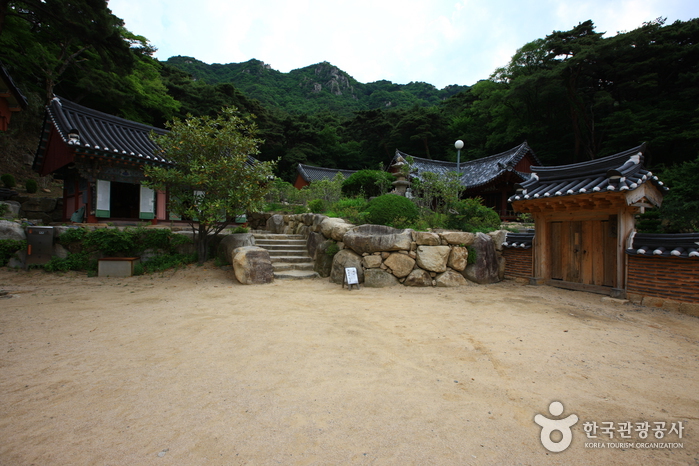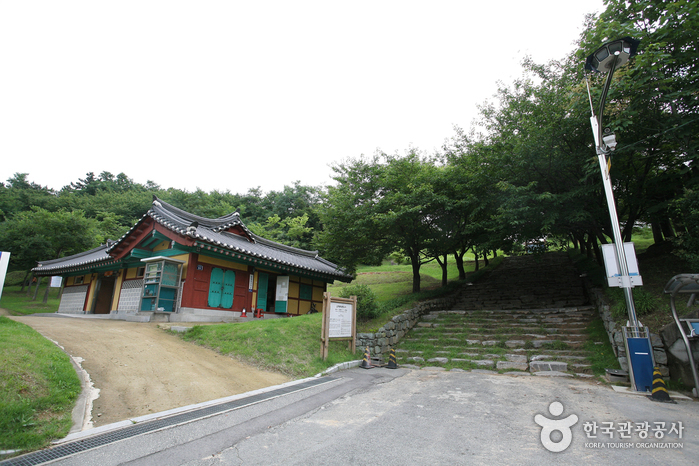Bunsanseong Fortress (김해 분산성)
19.1Km 2023-01-18
210-162, Gaya-ro 405beon-gil, Gimhae-si, Gyeongsangnam-do
+82-55-330-3925
Bunsanseong Fortress was constructed in the 3rd year of the reign of Goryeo's King U (1377) by Magistrate Park Wi to defend against foreign enemies, but it was destroyed during the Japanese invasion of 1592. The fortress we see today was reconstructed by Magistrate Jeong Hyeon-seok in the 8th year of the reign of Joseon's King Gojong (1871). However, it is estimated that it was first built during the days of Gaya. It is a temoe-style fortress with rocks piled up like a long band at the peak of Bunsan from which downtown Gimhae, Gimhae Plains, the Nakdonggang River and the South Sea are all in a single, panoramic view. Today, fortress walls remain stretching for some 900 meters on the slope towards the city and, inside the fortress, there are two gate sites in the south and north, an auxiliary gate on the west, a well site and several other building sites. The exact length of the remaining fortress walls is 929 meters and the average x_width is about 8 meters.
Inside the fortress lies Haeeunsa Temple, which was built to pay respects to Queen Heo of Garak who had come from the sea, according to stories. The temple also enshrines portraits of King Suro and Queen Heo that were painted during the Joseon dynasty. During the Japanese invasion of 1592, monk soldiers were stationed at this temple.
The fortress is more popularly called "Manjangdae" by Gimhae locals, and this name originated from the description, "A tall tower 10,000 (man) gil in x_height," granted by Daewongun in the Joseon dynasty for this advanced base that defeats Japanese invaders. A writing of "Manjangdae" written by Daewongun himself as well as his stamp are engraved on a rock behind a beacon that was restored in 1999.
Gimhae Eunhasa Temple (은하사(김해))
19.2Km 2021-02-24
167, Sineosan-gil, Gimhae-si, Gyeongsangnam-do
+82-55-337-0101
Eunhasa Temple is located in Sineosan Mountain in Gimhae, Gyeongsangnam-do. The year it was founded remains unknown, but legend has it that Monk Jangyuhwasang built the temple in AD 1, before the nationwide spread of Buddhism. However, relic pieces found at the temple site indicate the possibility of the temple's establishment in the Three Kingdoms Era. The temple was once burned down together with Dongnimsa Temple during the Imjin War and the architectural design seen today is that of the late Joseon dynasty.
Lotte Himart - Jeungsan Station Branch [Tax Refund Shop] (롯데하이마트 증산역점)
19.4Km 2024-04-19
154, Jeungsanyeok-ro, Mulgeum-eup, Yangsan-si, Gyeongsangnam-do
-
Gimhae Gaya History Park (김해가야테마파크)
19.4Km 2023-01-18
161, Gaya thema-gil, Gimhae-si, Gyeongsangnam-do
+82-55-340-7900
Gimhae Gaya History Park is a resting area that provides comfortable relaxation in the daily lives of the busy people and also a cultural complex where you can experience various cultures with your family, lover and friends.
Interactive theme park combining Education + Entertainment Edutainment park where you can see, hear, touch and learn about the history of Gaya and the brilliant heritage of its people through plays, experiences and exhibits.
Archaeological Site in Bonghwang-dong, Gimhae (김해 봉황동 유적)
19.4Km 2020-04-03
50, Garak-ro 63beon-gil, Gimhae-si, Gyeongsangnam-do
+82-55-330-3934
In 1920, the Archaeological Site in Bonghwang-dong, Gimhae was the first site to be excavated in Korea. The site includes an important shell mound from the Gaya period, as well as the Bonghwangdae Tomb, which was the largest tomb in the Geumgwan Gaya area. These important discoveries lead to the designation as Historical Site No. 2 on February 5, 2001. On top of the hill remain Yeouijangja Pavilion and Hwangsebawi Rock, which are part of the legend about General Hwangse and Yeoui.
Gimhae Korean-style house [Korea Quality] / 김해한옥체험관 [한국관광 품질인증]
19.5Km 2023-10-25
40 , Wangneung-gil, Gimhae-si, Gyeongsangnam-do
+82-55-322-4735~6
The Hanok Experience Center in Gimhae, Gyeongsangnam-do, offers guests a taste of old-time hanok life. Rooms are furnished with traditional items, while the spacious wooden floor can be used as a meeting room. Rooms in the sarangchae are on the small side but have an upper floor with scenic views. The room in the annexe building has a traditional sleeping mat surrounded by a large folding screen, and feels like a scene from a historical drama. Each room has a modern bathroom, There is a traditional experience program, and information services in English and Japanese.
Woljeon Fish Market (월전 활어판매장)
19.5Km 2024-02-26
154-21 Jukseong-ri, Gijang-eup, Gijang-gun, Busan
Woljeon Fish Market is a hub of stores specializing in raw fish and seafood freshly caught off the Gijang coast. This destination is ideal for those looking to purchase sea eels, sliced raw fish, and various seafood. Visitors have the unique opportunity to buy these items from the stores and then savor them at a nearby restaurant for an additional service charge. Notably, Woljeon Fish Market is renowned for offering some of the freshest conger eel in Busan. The stores are managed by fishermen themselves, ensuring that customers have access to fresh seafood at affordable prices.
Tomb of King Suro (수로왕릉)
19.5Km 2024-01-23
26 Garak-ro 93beon-gil, Gimhae-si, Gyeongsangnam-do
+82-55-332-1094
King Suro founded the Garak Kingdom in AD 42 and married Heo Hwang-ok, a princess from the Indian country of Ayuta, in AD 48. He was the founder of the Gimhae Kim family. Heo Yeop, a Yeongnam governor, gave the tomb its current look in the 13th year of the reign of King Seonjo (1580). The tomb compound includes various buildings, including the Sungseonjeon (where the ancestral tablets of King Suro and his queen are kept), Anhyanggak, Jeonsacheong, and Jegigo, as well as stone structures, such as a sindobi (tombstone) and gongjeokbi (monument established to pay homage the deceased). The tombstone in front of the royal tomb was built in the 25th year of the reign of King Injo (1647) of the Joseon dynasty. The name Sungseonjeon was bestowed on the tomb by King Gojong in the 21st year of his reign (1884).
Sureungwon Garden (수릉원)
19.6Km 2024-01-23
35 Bunseong-ro 261beon-gil, Gimhae-si, Gyeongsangnam-do
Sureungwon Garden is a place themed around the meeting between King Suro, the founder of Gaya, and Queen Heo, who was the princess of Ayuta Kingdom, known as India. The name Sureungwon Garden also contains the meaning of an elegant forest where King Suro and Queen Heo walked together. An ecological park measuring 39,600 m2 has been created along a low ridge that connects the Tomb of King Suro, an important cultural heritage of the Gaya period; the Ancient Tombs in Daeseong-dong, the tombs of the Gaya kings; and the Bonghwang-dong Historic Site. It was created by representing the maritime kingdom of Gaya, imagining a pond of the garden where King Suro and Queen Heo used to walk, and planting prickly waterlilies and yellow floating hearts that are believed to have inhabited wetlands in the Gaya period. Trails along the cozy forest and pond make it easy to look around comfortably.
Muji - Shinsegae Gimhae Branch [Tax Refund Shop] (MUJI 신세계김해)
19.6Km 2024-04-17
1F, 2232, Gimhae-daero, Gimhae-si, Gyeongsangnam-do
-


![Lotte Himart - Jeungsan Station Branch [Tax Refund Shop] (롯데하이마트 증산역점)](http://tong.visitkorea.or.kr/cms/resource/54/2890454_image2_1.jpg)

![Gimhae Korean-style house [Korea Quality] / 김해한옥체험관 [한국관광 품질인증]](http://tong.visitkorea.or.kr/cms/resource/81/3016981_image2_1.jpg)
![Muji - Shinsegae Gimhae Branch [Tax Refund Shop] (MUJI 신세계김해)](http://tong.visitkorea.or.kr/cms/resource/30/2885930_image2_1.jpg)
 English
English
 한국어
한국어 日本語
日本語 中文(简体)
中文(简体) Deutsch
Deutsch Français
Français Español
Español Русский
Русский